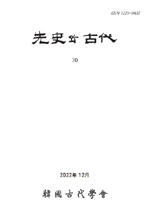新出 墓誌자료를 통해 본 遼西 豪族의 존재 양상과 隋‧唐의 懷遠鎭 鎭守
A Study on Aspects of the Existence of Powerful Clans(豪族) in the Liaoxi(遼西) Region and Sui and Tang’s Deploying Forces in Hoewonjin(懷遠鎭) Seen through Epitaph(墓誌) Newly Discovered
- 22

새로 나온 隋唐代 묘지자료를 이용하여 遼⻄ 豪族의 존재 양상과 懷遠鎭의 鎭守 문제를 살펴보았다. 520년대에서 6세기 말까지 中原 각지의 호족들은 北朝 제정권이 그 통치력을 발휘하지 못하고 있던 상황에서 재지사회의 질서를 유지하는 존재였다. 특히 이들은 鄕兵집단을보유하고 있어 그 거취가 정세 변화에 중요한 변수가 되었는데, 요서지역에서는 韓詳‧韓曁 부자나 趙世摸 같은 이들이 그러하였다. 고구려가 요서지역 호족을 확보했던 것 역시 이러한이유에서였다고 보인다. 여느 시대에나 있을 법한 영역 확대나 지배과정에서 현지 세력의 협조, 지지를 이끌어내기 위한 포섭이라기 보다는 ‘北魏 末’이라는 특수한 상황에서 고구려는요서 호족들의 지지와 협력이 필요했던 것이다. 요서 호족의 정치‧군사적 역량은 요서로 진출한 고구려가 이 지역에 거점을 마련하고 세력을 확대해 나가는데 상당한 역할을 해 줄 수 있었다. 이러한 이해를 토대로 한기가 遼澤에서 사망했다는 사실에서 수가 요서호족 한기를 내세워 고구려 ⻄邊을 살피고 있었다는, 그동안알지 못했던 내용에 대해서도 확인할 수 있었다. 한상‧한기 부자의 이력은 요서 호족이 520년대 이래 상당 기간 고구려의 요서 경영에 협력했지만, 6세기 말에 이르러서는 수의 첨병으로활약하게 되었음을 보여준다. 요서로 진출한 수는 그 최전선에 군사기지로 鎭‧戍를 세웠는데, 懷遠鎭과 瀘河鎭이 그 일부였다. 이들의 주 임무는 고구려 방면의 국경을 방어하는 것이었다. 그러던 회원진과 노하진이 611년 무렵에는 고구려 침공군의 군수 보급기지로 운용되었다는 것은 이들이 전선의 후방에 자리잡게 되었음을 알려준다. 이들을 보급기지로 운용할 수 있을 만큼 수는 고구려의 서변을 잠식해 들어와 있었던 것이다. 한편 612‧613년의 침공이 실패로 끝난 직후에 모습을 보인 회원진은 當代에 이름을 떨친고위급 무장들이 이곳의 진수를 맡았다는 점에서 종래와 다른 성격의 기지였다. ‘東北道⼤使’ 의 직으로 보아 한동안 동북 방어의 핵심기지 역할을 수행했던 것으로 보인다. 고구려 침공의실패가 불러올 후폭풍에 대비한 조치였다. 이러한 시각에서 645년 당 태종의 고구려 침공에 종군했던 조사달이 이듬해 회원진을 진수했다는 <趙士達墓誌>의 기재내용은 고구려 침공 실패가 불러온 위기의 구체적인 양상을 우리에게 전해준다. 묘지는 그의 회원진 진수를 ⻄晉末 홀로 河北을 지키면서 前趙와 後趙에 대항했던 劉琨의 활약에 견주었다. 회원진은 수대 이래 요서 동부에 마련된 중원왕조의 핵심기지였다는 점에서 당이 입은 타격이 생각 이상으로 심각했음을 알려주는 것이다.
This study examined the aspects of the existence of powerful clans (豪族) in the Liaoxi region (遼 ⻄) and the issue of deploying forces in Hoewonjin (懷遠鎭), using newly discovered grave records from the Sui and Tang Dynasties. From 520 to the late 6th century, powerful clans in different parts of the Central Plain (中原) maintained order in local societies while all authorities of the Northern Dynasty could not exercise their ruling power. In particular, they possessed local soldier (鄕兵) groups and thus their position was an important variable in the change of situation. In the Liaoxi region, Han Sang (韓詳) and Han Gi (韓曁), who were thefather and son, and Jo Semo (趙世 摸) were from such powerful clans. This seems to be the reason why Koguryeo won over powerful clans in the Liaoxi region. It was not exactly winning over local powers to elicit cooperation and support from them in the process of expanding a territory or ruling, which would likely be the case in any era. Koguryeo needed the support and cooperation of powerful clans in the Liaoxi region in the special situation of the Late Northern Wei (北魏). The political and military capabilities of powerful clans in the Liaoxi region could play a significant role for Koguryeo to establish a foothold there and expand its influence. Based on this understanding, this study found that Sui was paying attention to Seobyeon (⻄邊), Koguryeo, using Han Gi, who was from a powerful clan in the Liaoxi region from the fact that Han Gi died in Yotaek (遼澤). This was not known before. The history of Han Sang and Han Gi, the father and son, shows that powerful clans in the Liaoxi region had cooperated with Koguryeo for its influence there for a long time since 520, but by the late 6th century, they worked as an advanced guard for Sui. Sui entered the Liaoxi region and established their military bases called Jin (鎭) and Su (戍) (Su) at the forefront, and Hoewonjin (懷遠鎭) and Nohajin (瀘河鎭) were part of the military bases. Their main mission was to defend the border with Koguryeo. By 611, Hoewonjin and Nohajin were operated as military supply bases for the army invading Koguryeo, which indicates that they werelocated behind thefront line. Sui operated them as military supply bases because it had deeply encroached on Koguryeo's west coast. On the other hand, right after Sui’s invasion of 612-613 failed, renowned and high-ranking military commanders deployed forces in Hoewonjin. During this period, Hoewonjin’s nature as a military base was different from the previous one. It can be seen from the position ‘dongbukdodaesa (東北道⼤使)’ that Hoewonjin was a key military base for defending the North-eastern area for some time. It was a measure to prepare for the aftermath of the failure in invading Koguryeo. From this perspective, the record on Josadalmyoji (趙士達墓誌) that Jo Sadal, who fought for Tang's invasion of Koguryeo in 645 during the reign of Emperor Taizong, deployed forces in Hoewonjin tells us a specific aspect of the crisis caused by the failure in invading Koguryeo. Records in Josadalmyoji compared Jo Sadal’s deploying forces in Hoewonjin to Yu Gon’s (劉琨) brilliant exploit when he alone defended Habuk (河北) against the Former Zhao (前趙) and the Later Zhao (後趙) during the late Western Jin Dynasty (⻄晉). This shows that the blow suffered by Tang was more serious than expected as Hoewonjin had been a key military base of the Zhongyuan Dynasty and had been prepared in the eastern Liaoxi region since the Sui Dynasty.
Ⅰ. 머리말
Ⅱ. 요서지역 호족의 또 다른 사례, <趙世摸墓誌>
Ⅲ. 고구려의 요서 진출 시기와 그 이후 요서 호족의 동향
Ⅳ. 隋‧唐의 懷遠鎭 鎭守와 그 의미
Ⅴ. 맺음말
참고문헌
(0)
(0)